Today we have a good buddy of mine and the first person to mention the term “social PR” to me years back. She’s on lots of best-of lists and should definitely be on yours.
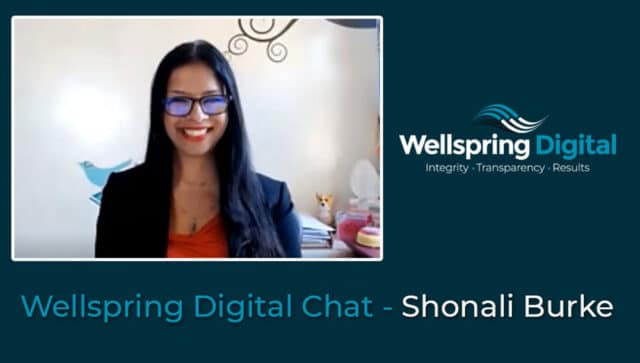
We get to the bottom of:
- Why creativity is about being nimble, flexible, and versatile
- Human to human marketing
- Why brands need to listen too
- Why for-profits should be purpose-driven too
- Are marketing and education linked?
Great stuff in here! Enjoy!
Digital Transcription – Edited for Readability
Introductions
Jon-Mikel Bailey: I am Jon-Mikel Bailey and welcome to the Wellspring Digital Chat. This is when we find and basically kidnap marketers, we take them to a secure location. We grill them for a good bit of time until they’ve basically told us what we need to know. And then we release them back into the wild. (no marketers were harmed in the making of this podcast)
So today, we have a good buddy of mine. And the first person I’ve ever heard mentioned the term social PR, and this was years ago. She’s on tons of lists, and she should definitely be on yours. So Shonali, go ahead and introduce yourself to these fine, folks.
Shonali Burke: Hey, fine folks. And hey, Jon-Mikel, thank you for having me, it is great to be with you at this undisclosed location. The location of which we cannot disclose to anyone ever, because otherwise, we might have to kidnap one of y’all as well. But anyway, I’m Shonali Burke, it’s an absolute pleasure to be here for a Wellspring digital chat.
I, as Jon-Mikel has said, have been in the marketing communications field for a while now. I’ve worked in small and large agencies, very large nonprofits as well have been running my own consulting practice for more than a decade now. So that is going to change in the hopefully near future as well.
And I also teach I am faculty for Johns Hopkins University for the MA communication program. And my focus, as Jon-Mikel alluded to, I kind of grew up in traditional PR, fell into social media and created this, this idea of what I call “social PR,” which is really how do you socialize the conversation and use that to build relationships for the good of your organization?
But parallel to that, and perhaps congruently with that is my interest and deep interest, I would say, in metrics and analytics. So really, when those of us who work in marketing and public relations are looking at creating and strategizing campaigns for our organizations, or our clients, how do we know we’re actually changing something? How are we moving towards specific outcomes? And that’s, that’s, that’s what I love to figure out.
Jon-Mikel Bailey: I’m always happy to hang with you, preferably in person, but you know, an undisclosed location will have to do anyway. So now I get to share you with my entire audience. And I think we’re gonna give them some good stuff. So you’re ready to roll. I’m ready to rock. Let’s do this.
Creativity Is about Being Nimble, Flexible, and Versatile
Jon-Mikel Bailey: So you offer a masterclass on social PR, which I highly recommend. In the end, you wrote a blog post sort of explaining the concept. And there’s a line in this post that I want to ask you about. And the line is, “what creativity is really about is being nimble, flexible, and versatile.” I love that. I think this is more important now than ever. And I wanted to ask you, what does that line bring to mind for you in our, you know, current comms and media environment?
Shonali Burke: Yeah, thank you, Jon-Mikel. When I came up with that, and as you referenced about this, that post of mine, it’s built on the 7 C’s Social PR framework that I created. And see the sea of creativity is one of those. And what used to really irked me and I’m becoming a little bit better about not letting it get to me is if, you know, marketers, in particular, the whole world, but particularly marketers running after the next shiny toy, right?
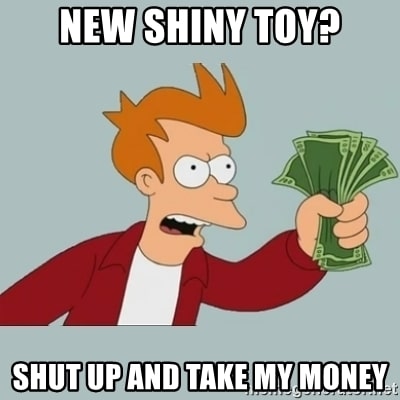
So when it’s, “oh, let’s use this, let’s be creative. And, and you will create it.” It’s like, “Oh, my God, creativity is not about the app. It’s not about the cool video you can do,” though, oftentimes it is, but it’s not. That’s not what it’s about. It’s how are you thinking differently? How are you thinking differently and creatively about what your client or your organization needs, what your stakeholders need? And how you bring the two together more efficiently, more effectively?
If there’s technology around you, how are you using that? How are you optimizing it to achieve your goals? And that’s what creativity really is for me. So yes, sometimes it results in these wonderful campaigns that kind of get seared into your mind like the one that the agency did. Was it Wieden Kennedy, you know, the man your man could smell like, that is brilliantly creative?
But with that went one step further was in the interaction, you know, the interactivity that they had with people on Twitter and how that just kind of continued. It wasn’t a flash in the pan. They continued that for days. And it made it did have an impact. I think we talked about this when we were at xPotomac several years ago.
It did have a significant lift for the brand. And you know, on a business level, that’s creativity, yes, they had a lot of resources to put together some really cool, creative, but they went above and beyond when it came to really connect with their audience, really making those making everyone feel differently about the brand. That, to me, is what creativity really is about.
So for us as marketers, not only in our work, do we need to approach things in a more creative way. But how are we recreating ourselves? What are we doing to continually add to our own professional development to our expertise? You know, I think, you know, folks like you and I, and our friend, Geoff Livingston, and so many others that we know, we’re all very committed and giving back to our community as much as we can.
And we’ve done that over the years, we’ll continue to do it as much as we can. How are we sharing what we learn? How are we growing ourselves? How are we helping others grow? That’s why I created the master course. That’s why you created this medium for conversation. You know, that is really what I think all of us need to keep in mind when it comes to creation and creativity as well.
Jon-Mikel Bailey: Amen, sister. So, I mean, you just reminded me of xPotomac. And now I’m going to be sad for a mini second because I miss actual events. But someday we’ll get back there.
Human to Human Marketing
Jon-Mikel Bailey: So I want to talk about acronyms. We all know about, you know, B2C, and B2B, which is business to consumer and business to business. But a new acronym over the past few years is getting a lot of attention. And I think it’s worthy of a discussion, especially after going back through and reading some of your stuff. I want to ask you about the new acronym, which is H2H, human to human, humans selling, and marketing to humans. I want to leave this wide open because I think I’ll get a better answer that way. So what does H2H mean to you?
Shonali Burke: So this is where I confess that I’ve been living under a rock because I haven’t actually heard that acronym until you shared it with me. But in my defense, I did go back to school. So I was kind of studying. I think it comes back to back in the day, we used to say B2E, business to everyone.
And it’s, to me, a reminder that people don’t do business with faceless corporations, or, you know, buildings that are very beautiful. People do business with people. Think about your own work or clients that you’ve worked with when you’re looking at maybe different people that you want to partner with or vendors.
You might have a sea of people who all have the same level of qualifications, the same level of experience, the one you’re going to work with is one you have a connection with, right back to connections, human. I mean, I’m not trying to oversimplify, but I think it literally is as simple as that. It’s just, talk to people.
And I think, you know, when you and I started out on social, that was something we experienced early on. Hopefully, that’s what we’ve retained in our work, at least for the most part, and that we continue to retain. And that’s why I think, you know, well, can you do a B2B or can you do B2C, or you don’t have this experience? You know, vertical experience is great.
And yes, there are certain things in certain industries, you need to know how certain regulations function or in certain industries that you know, might have more of a governmental affairs influence, you need to be more up to speed on legislation, and so and so, which we should be in our industries anyway. But at the end of the day, whoever your stakeholders are, they’re human, as of now, they’re still human.
Jon-Mikel Bailey: As far as we know, yeah.
Shonali Burke: So it doesn’t matter as we know, yeah. So it doesn’t matter, really. Is it public affairs? Are you talking to regulators? You have a whole bunch of consumers, the scale on which your work will vastly differ, how you are employing your tactics I think could vastly differ. But everyone wants to be spoken to like a human being.
Everybody wants to know that they that if they have concerns, they’re able to voice them, and that they’ve been heard. And that aspect of listening and engaging and actually having a real conversation is universal. And I think at the core of why H2H is not a buzzword.
Why Brands Need to Listen Too
Jon-Mikel Bailey: So, that was a great lead into my next question. It’s almost as if you’ve seen these questions before. Goodness. So part of the whole human-to-human thing is that you have to listen like you just said. And I hear that too in your post about the ultimate social PR strategy. It’s one of your seven, it’s one of your C’s in your 7C Social PR framework, which you already mentioned. And I’ll link it here for people to check out because they should.
But do you think brands still struggle with the listening part of the conversation they’re having with their customers? And you made mention of us exchanging on social media back in the day in the early days. And that makes me think I wonder if we’ve gotten too far away from that?
Shonali Burke: Yeah, I really, you know, simple. It’s almost ironic because you have so many listening platforms, you have so many tools. So it’s almost like there’s so much, that we’ve stopped doing it. Perhaps one of, not perhaps, I would say definitely one of the positive outcomes of the pandemic, is that any brand that has survived so far had to start listening if it wasn’t doing it before.
You know, because before it could kind of really “No, we’re just gonna pretend we don’t hear anything.” But you can’t go out into the real world, all of your connections, and all of your conversations are virtual, you have to listen. There’s just there’s no alternative. So, you know, sometimes the greatest change comes out of significant tragedy, and this entire pandemic has had so many tragic consequences.
And unfortunately, I think there will be more tragedy before we can say we’re kind of we’re through it, we’re not yet through it. But perhaps one of the positive outcomes is that people and brands have really understood the importance of listening and that they’re doing it for now. Will it continue to do it after things are settled on? Honestly, I have no idea because you’re already starting to hear but you know, we want to bring people back to the office.
And we were “Well, sure, I understand that there’s a lot of value to being in the workplace.” Absolutely. You know, I would want that myself, at least to some extent. But when you’ve had globally, everyone has had to work at home, although those of us who’ve been lucky enough to be able to do it, have had jobs that we could do virtually. And organizations have experienced what that is like for their employees. And for themselves.
They’ve seen that business continues, they’ve seen that productivity can still happen. At that point, to then not listen to your employee base, which is one of your most important audiences ever, and say “yeah, well, that was okay, for a year and a half and open to go back to normal.”
There is no more normal, you’ve got to figure out the new normal. So in that case, I think, you know, I think it’s gonna be very tough for organizations that want to try and reclaim the past because the past doesn’t exist anymore. You know, but hopefully, hopefully, that will not be the norm.
Jon-Mikel Bailey: It’s almost as if, you know, the bar’s been set, and if they don’t pay attention and stay with the times, it could be really bad for them. I think in some respects.
Shonali Burke: It’s so interesting, because if you look at the history of innovation, and let’s face it, this entire global catastrophe, of the pandemic, has thrust innovation upon who didn’t want to or didn’t think they needed to innovate. And that’s so much more than just adopting new technology.
It’s really restructuring how you do business, how you’re creating value, and how you’re capturing value. But if you look at the history of innovation, it is littered with companies that just didn’t want to listen, that didn’t want to pay attention. I mean, one of the classic examples is Kodak with digital technology, they had the technology right there. They didn’t want to focus on it. They didn’t listen.
Jon-Mikel Bailey: It still breaks my heart.
Shonali Burke: I know.
Why For-Profits Should Be Purpose-Driven Too
Jon-Mikel Bailey: So, as kind of an add-on to that you’ve worked with a lot of purpose-driven organizations like USA for UNHCR, the ASPCA, which I love, and you’ve worked with them on their communications efforts. But I want to ask what lessons have you were learned working with those organizations that a for-profit group might learn from? Especially now, in the environment that we’re in?
Shonali Burke: That is a great question.
Jon-Mikel Bailey: I’ll be here all week.
Shonali Burke: You kind of know when anyone goes “that’s a great question,” it’s a stalling tactic. Not so much a stalling tactic but, which one should I pull out? You know, I think with the USA for UNHCR and the ASPCA, yes, both great organizations, very, very mission, and purpose-driven, but very different also in their structure.
You know, ASPCA is huge, USA for UNHCR is not. The resources available, are very, very different or were at least at the time that I worked with them. But what I appreciated about both of them was that they focused on outcomes. You know, they, and perhaps part of that was driven by the fact that they are non-profit organizations. And so, you know, there’s that responsibility to their donors and their funders.
Which, of course, for-profit organizations have as well, to their, they have a fiduciary responsibility. But it feels like, (there’s Lola), it feels like leadership might forget that once in a while. I think because we’re focused on okay, how are we maximizing our donor dollars? How are we maximizing what’s coming in to not just, you know, keep the lights on, but actually to fulfill our mission, they were always looking to see how they could be efficient and, and optimize.
And really the level of watch virtual work that was possible with the ASPCA, for example, I’m talking 2006, that was not the norm to have, you know, a good, you know, a significant percentage of your workforce spread out all over the country, be remote, and I’m talking about at very high levels as well.
So really, to be, you know, taking advantage of technology, to be making it possible for people to live and work where or live where they needed to, but still do the work that they were passionate about, really trying to cater to your well being. I really, really appreciated that.
And it was the same with USA for UNHCR, you know, in their case, it was a very small staff, pretty resource-strapped but because of that, really leveraging the virtual space and technology. We’ve come a long way since those days, we have a lot more technology at our disposal, but it is shocking to me how little of it people still use.
You know, again, not to keep bringing the pandemic up, but I suppose I am. You and I were doing virtual stuff, and our colleagues have been doing it, but a lot of organizations were not, And it’s like, but why not? Why were doctors not doing electronic medical records? Why couldn’t you make an appointment with your physician online? Everybody’s doing it now?
Why couldn’t you do a virtual console and then see if you needed to come in, you know, all of these things could have been implemented a long time ago and saved a lot of money. Hmm. But they weren’t.
Jon-Mikel Bailey: You mentioned something in there that I want to kind of touch on, that, you know, these organizations had a responsibility to their members. And I wonder, like, do for-profit companies need to sort of take that same kind of approach and think about their customers the way say an association or some sort of member organization would think about their members, that it’s more, it’s less about how can we sell them more? And it’s, it’s more about how can we do right by them? You know what I mean?
Shonali Burke: Yeah, absolutely. And if you think about it, you know, so let’s go back to 1982 and the Tylenol crisis? I mean, Johnson and Johnson classic. Wow. You know, what James Burke did then he said, “we’re going to do what’s right for the customer.” To really to think about it, you know, and the details are fresh in my mind because I had to research it for a class that I’m developing.
I think that was like in less than a week from the first deaths – for any of your audience who don’t know we’re talking about when there some Tylenol bottles were tampered with and replaced with cyanide. Instead, we have all those little safety things tamper-proof seals. And that happened in the Chicago area.
And but literally, in less than a week, there was a nationwide media blitz, you literally had J&J saying, “Please do not take Tylenol.” I mean, their market share was crazy. Like, I’m not going to give you the number right now because it’ll be wrong, but it was significant. And, and they were the dominant player, I believe, at the time in over-the-counter pain relief.
And in less than a week, they had pulled it from every single shelf in the country. That’s remarkable. Because they were so bound to their credo which was to do right, by the customer, do the right thing by the customer, and the profits will follow. If you think about it, that is really what corporate responsibility means. The right thing, not make the most money, do the right thing.
Jon-Mikel Bailey: Do the right thing, Spike.
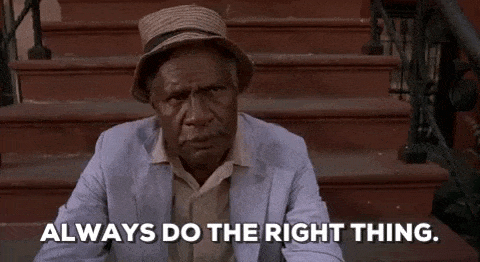
Are Marketing and Education Linked?
Jon-Mikel Bailey: All right. My last question, I come from a long line of educators, you come from a long line of educators, and I want to talk about learning and education because most marketers that I know are avid readers, some are educators, and some of the best thinkers I’ve ever met. I would say some are even just ridiculously clever, and just fun to be around. But what I want to know is is how are marketing and education linked both in the industry? And in terms of the practice of marketing?
That’s another one, hmmm.
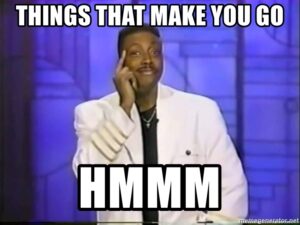
Shonali Burke: That’s another one. Um, well, I mean, I could talk till the cows come home about education.
Jon-Mikel Bailey: Why is it that marketers are constantly interested in education? And and and how do you think or does it translate into the practice of marketing?
Shonali Burke: Well, perhaps we all have short attention spans. So we need to keep refocusing on something? Squirrel!
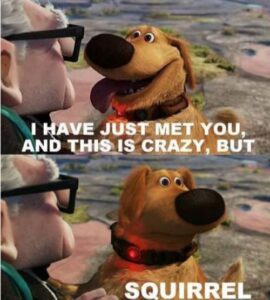
No, I think, I love what you said about marketers are really fun to hang out with. And perhaps I just got so used to it, that when I was around non-marketing people I was like… Marketers are fun. And I think that’s because as a breed, you’re curious. We’re curious, we like to make things happen. You know, people talk smack about marketing, but the world wouldn’t exist without it. So marketing is a hugely important part of everyday life.
Jon-Mikel Bailey: What is it? It’s the third oldest profession? Maybe.
Shonali Burke: But if you think about it was probably part of the first oldest profession, if there wasn’t any marketing, it wouldn’t exist? So marketing’s like, like profession zero. Ground Zero. So I think it’s, you know, one is we are curious, we want to know more about how things work. We like knowing, those of us who pride ourselves on our work, need to know how things work so we can make them work better for our clients and for our organizations.
And part of that a huge part of that is educating yourself because if you don’t understand something, you need to in order to be able to implement it for the client of your organization. We look at social media, social media is a great example. Like, we didn’t know what the heck was going on. And we were like, what Twitter? Like what, okay, so what, wild.
So I think part of it is that, that you know, there’s this new thing out there, we should probably at least understand it to see if it makes sense to implement. And, and I think also by nature, because we like to share we are compulsive sharers I think we end up sharing that knowledge, which is a beautiful thing.
Whether we like whether we know we’re doing it or not, I mean, in a form this is educational, I hope for at least somebody who’s watching or listening. And if that’s useful, even one person then that’s pretty awesome.
Jon-Mikel Bailey 24:53
I think you so you mentioned one C-word. I don’t know if it’s your C-word, but curiosity. And, and but another word that you use is collaboration, I believe, right? And I think, it kind of reminds me of playing music because I play the drums. And it’s kind of the same thing like hanging out with the musicians kind of feels like hanging out with marketers.
It’s fun. It’s interesting, we’re all curious, we like to talk about music, we like to talk about marketing. And so I think collaboration is just a normal extension of that they marketers are, you know, not necessarily inherently social, but they want to do marketing, and they want to work with other people.
Shonali Burke: Yeah, that’s such a good point. And I think also, it shows a level of confidence in yourself if you’re willing to do that because I think people who collaborate well are very confident in their abilities. And they’re like, “Okay, this is what I bring to the table, you got something pretty good there, let’s do this. Let’s figure out how to do it together,” and you kind of make each other better.
And so it’s a very healthy collaboration, it’s healthy sharing, it’s a healthy partnership, as opposed to what can often happen, particularly in the corporate space, where you have somebody who’s super strong, other team members who might not be and then there’s kind of lopsided, and not every relationship is, you know, perfectly healthy and equal all the time. Of course not.
But for the most part, you think it is, and it kind of corrects as you go along. So that’s a really good point about marketers being willing to do that. And yeah, I haven’t thought about it in the musical context. But that makes so much sense. It’s kind of like you’re jamming together, you’re like, “Okay, what’s the scope? What can we put can we create from this day that others see creativity?”
Jon-Mikel Bailey: And I literally asked this question from my drum throne, because it’s what I sit in for my interview, so it really, it all comes together.
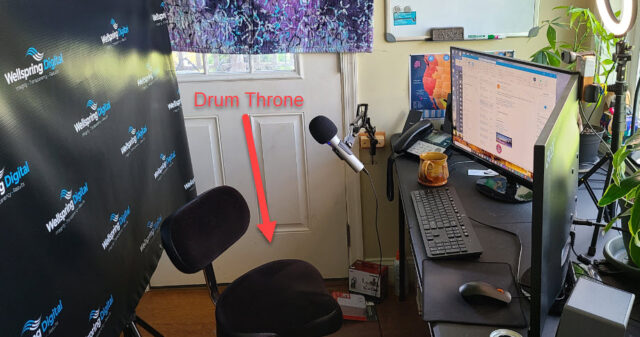
Shonali, this was fun. And in the interest of full disclosure, Shonali actually kidnapped me, forced me to ask her these questions. So please send help. You know, this was a blast. I really appreciate talking to you. I could talk to you all day. I will share all your stuff. Hopefully, I get to see you in real life very soon. And, you know, best of luck in the days to come. Let’s go kick some butt.
Shonali Burke: Thank you so much, my friend, this was really fun. Thank you very much for inviting me. I appreciate the opportunity to chat. It was just really good to see you. And yes, I hope Um, the next calendar year is over, we get to.
Jon-Mikel Bailey: Amen. All right. Thank you. Bye, everybody.